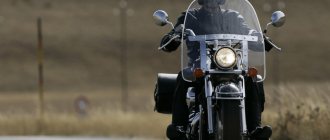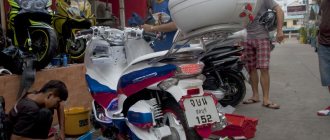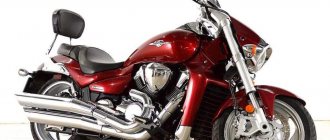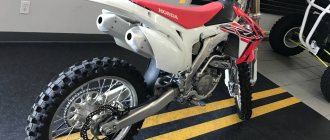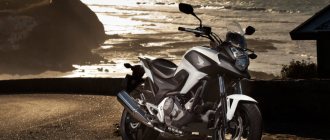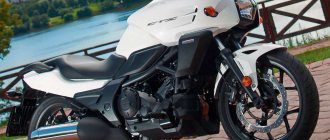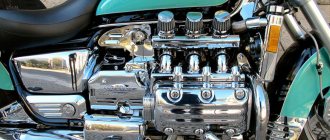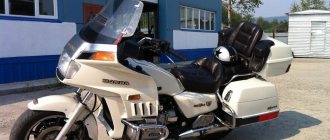| Honda CB750 Nighthawk (North America) 1991-2003 | Honda CB750 F2 Seven Fifty (Europe, Japan) 1992-2001 | Honda CB750 F2 Seven Fifty (Japan) 2004-2008 |
Model of the classic road motorcycle Honda CB 750
begins its history in 1969, but the most interesting and still used models are those starting in 1991 and produced until 2003 (for the Japanese market - until 2008). The appearance of this model was due to Honda’s desire to compete with the then popular classic Kawasaki Zephyr 750 model.
In 2007, Honda decided to resurrect the legendary motorcycle by releasing the Honda CB 750 Special Edition in silver colors. This version of the motorcycle was sold only in Japan.
A special feature of the Honda CB 750 is an in-line 4-cylinder air-oil-cooled engine with a capacity of 747 cc. see, producing 75 hp. power and almost 64 Nm of torque. The engine is equipped with hydraulic compensators and does not require periodic adjustment of valve clearances.
Main modifications of the Honda CB 750:
- Honda CB 750 F2 Seven Fifty
(1992-2001) - European version. The model features a classic appearance, dual front brakes and a rear disc brake. In Japan, the model was available from 1992 to 1995. In 2001, the model underwent minor changes and was produced in Japan until August 2008. - Honda CB 750 Nighthawk
(1991-2003) - American version. The model has a more cruiser-like appearance, with a single disc brake at the front and a drum brake at the rear.
The Honda CB750 model was often used for training in motorcycle schools, so you can find “strangled” training versions of this motorcycle on the market. They can be distinguished by black mufflers, the absence of a handle for the passenger, a black dashboard housing (instead of chrome “glasses”), the absence of remote reservoirs on the rear shock absorbers, the presence of a fan on the oil cooler (not always), a 2-piston rear caliper and hydraulic clutch. Very often, they try to visually transform educational versions into full-power ones, so educational models offered on the market may not always contain all of the listed differences.
The main competitors of the Honda CB 750 in the class:
- Suzuki GSF 750 / Suzuki GSX750 Inazuma
- Kawasaki ZR-7 / Kawasaki Zephyr 750
- Yamaha FZX 750
Brief history of the model
- 1991 - launch of the Honda CB 750 NightHawk.
Model:
Honda CB750 Nighthawk (North America).
Frame number:
JH2RC381MMXXXXXX.
- 1992 - launch of the Honda CB 750 F2 Seven Fifty modification. The model is available in Europe and Japan.
Model:
Honda CB750 Nighthawk (North America), Honda CB750 F2 Seven Fifty (Europe, Japan).
Frame number:
JH2RC381NMXXXXXX (North America), RC42XXXXXXX (Europe), RC42-100XXXX (Japan).
Model code:
CB750F2N (Europe).
- 1993 - European version temporarily discontinued.
Model:
Honda CB750 Nighthawk (North America), Honda CB750 F2 Seven Fifty (Japan).
Frame number:
JH2RC381NMXXXXXX (North America), RC42-100XXXX (Japan).
- 1994 - The American version of the Nighthawk is temporarily discontinued.
Model:
Honda CB750 F2 Seven Fifty (Japan, Europe).
Frame number:
RC42-100XXXX (Japan), RC42XXXXXXX (Europe).
Model code:
CB750F2R (Europe).
- 1995 - CB750 F2 Seven Fifty changes a bit. The color red appears and the rims are available in black (instead of silver).
Model:
Honda CB750 Nighthawk (North America), Honda CB750 F2 Seven Fifty (Europe, Japan).
Frame number:
JH2RC381SMXXXXXX (North America), RC42XXXXXXX (Europe), RC42-110XXXX (Japan).
Model code:
CB750F2S (Europe).
- 1996 - Japanese version no longer produced.
Model:
Honda CB750 Nighthawk (North America), Honda CB750 F2 Seven Fifty (Europe).
Frame number:
JH2RC381TMXXXXXX (North America), RC42XXXXXXX (Europe).
Model code:
CB750F2T (Europe).
- 1997 - no significant changes.
Model:
Honda CB750 Nighthawk (North America), Honda CB750 F2 Seven Fifty (Europe).
Frame number:
JH2RC381VMXXXXXX (North America), RC42XXXXXXX (Europe).
Model code:
CB750F2V (Europe).
- 1998 - no significant changes.
Model:
Honda CB750 Nighthawk (North America), Honda CB750 F2 Seven Fifty (Europe).
Frame number:
JH2RC381WMXXXXXX (North America), RC42XXXXXXX (Europe).
Model code:
CB750F2W (Europe).
- 1999 - no significant changes.
Model:
Honda CB750 Nighthawk (North America), Honda CB750 F2 Seven Fifty (Europe).
Frame number:
JH2RC381XMXXXXXX (North America), RC42XXXXXXX (Europe).
Model code:
CB750F2X (Europe).
- 2000 - Only the American version of the Nighthawk is available.
Model:
Honda CB750 Nighthawk (North America).
Frame number:
JH2RC381YMXXXXXX (North America).
- 2001 is the last year of production of the European version of the F2 Seven Fifty, and the model is again available in Japan. The bike gets a new exhaust and carburetors to meet the updated emission norms. The rear suspension is simpler, without a compensation tank. The belt on the passenger side of the seat has been removed.
Model:
Honda CB750 Nighthawk (North America), Honda CB750 F2 Seven Fifty (Europe, Japan).
Frame number:
JH2RC3811MXXXXXX (North America), RC42XXXXXXX (Europe), RC42-125XXXX (Japan).
Model code:
CB750F21 (Europe), CB750FII1 (Japan).
- 2002 - Only the American version is produced.
Model:
Honda CB750 Nighthawk (North America).
Frame number:
JH2RC3812MXXXXXX (North America).
- 2003 - no significant changes. Last year of release.
Model:
Honda CB750 Nighthawk (North America).
Frame number:
JH2RC3813MXXXXXX (North America).
- 2004 - The F2 Seven Fifty version begins production again, but only for the Japanese market. The model gets new colors, multi-reflector headlight, electric speedometer, electronic odometer, immobilizer (HISS) and new carburetors with throttle position sensor. The rear suspension is being changed, which again receives compensation shock absorber reservoirs.
Model:
Honda CB750 F2 Seven Fifty (Japan).
Frame number:
RC42-135XXXX.
Model code:
CB750FII4.
- 2006 - new colors appear.
Model:
Honda CB750 F2 Seven Fifty (Japan).
Frame number:
RC42-160XXXX.
Model code:
CB750FII6.
- 2007 - the appearance of a special version of the motorcycle - Honda CB750 Seven Fifty Special Edition.
Model:
Honda CB750 F2 Seven Fifty (Japan).
Frame number:
RC42-170XXXX.
Model code:
CB750FII7.
- 2008 is the final year of production of the Honda CB750 F2 Seven Fifty.
Model:
Honda CB750 F2 Seven Fifty (Japan).
Frame number:
RC42-171XXXX.
Model code:
CB750FII8.
Peculiarities
The Sibikha 750 is intended for those who don’t have enough drive of the 400, but don’t need the massiveness of the 1300 either. This is a balanced road bike of medium cubic capacity, dynamic, but at the same time hardy, reliable and as simple as possible. At the same time, it is equipped with a comfortable seat and provides a comfortable fit, that is, driving will be as relaxed as possible. The motorcycle is easy to control, but in static conditions it feels heavy. This is not just a stylization of a half-century-old model; the 750 is actually created according to the design of its predecessor. Frame, engine, suspension fork and 2 shock absorbers, transmission, carburetors and drive chain - everything. No fancy body kit, just a round headlight and an analog instrument panel.
Specifications
Technical characteristics of Honda CB 750 (F2 Seven Fifty, Nighthawk):
| Model | Honda CB 750 (F2 Seven Fifty, Nighthawk) |
| Motorcycle type | road (classic) |
| Year of issue | 1991-2003 (2008) |
| Frame | steel duplex |
| engine's type | 4-cylinder, 4-stroke, in-line |
| Working volume | 747 cm³ |
| Bore/Stroke | 67.0 mm x 53.0 mm |
| Compression ratio | 9,3:1 |
| Cooling | air-oil |
| Number of valves per cylinder | DOHC, 4 valves per cylinder (with hydraulic compensators) |
| Fuel supply system | carburetor, 4x Keihin 34 mm (VE66X, VE77X – CB750 (1991-2000), VENAC – CB750 (2001-2008) |
| Ignition type | transistor |
| Maximum power | 75 hp (55 kW) at 8500 rpm |
| Maximum torque | 64 Nm (6.5 kg*m) at 7500 rpm |
| Clutch | Multi-disc in oil bath, cable drive |
| Transmission | 5-speed |
| type of drive | chain |
| Front tire size | 120/70-17 58V – CB750 F2 Seven Fifty 110/80-18 58H – CB750 Nighthawk |
| Rear tire size | 150/70-17 69V – CB750 F2 Seven Fifty 140/70-17 66V – CB750 Nighthawk |
| Front brakes | 2 296 mm discs, 2 piston calipers - CB750 F2 Seven Fifty 1 296 mm disc, 1 piston caliper - CB750 Nighthawk |
| Rear brakes | 1 240mm disc, 1 piston caliper – CB750 F2 Seven Fifty drum – CB750 Nighthawk |
| Front suspension | 41 mm telescopic fork, travel - 130 mm (140 mm - Nighthawk) |
| Rear suspension | pendulum with two shock absorbers (adjustable preload), stroke - 110 mm |
| Length | 2220 mm (2185 mm - Nighthawk) |
| Width | 780 mm (800 mm - Nighthawk) |
| Height | 1100 mm (1135 mm - Nighthawk) |
| Wheelbase | 1495 mm (1505 mm - Nighthawk) |
| Seat height | 795 mm (780 mm - Nighthawk) |
| Minimum ground clearance (clearance) | 130 mm – CB750 F2 Seven Fifty 140 mm – CB750 Nighthawk |
| Acceleration 0-100 km/h (0-60 mph) | 3.9 sec[1] – CB750 F2 Seven Fifty 4.47 sec.[2] – CB750 Nighthawk |
| Maximum speed | 206 km/h[3] (180 km/h - Japanese versions) – CB750 F2 Seven Fifty 190 km/h[4] – CB750 Nighthawk |
| Gas tank capacity | 20 l (including 3 l reserve) – CB750 F2 Seven Fifty 18 l (including 3 l reserve) – CB750 Nighthawk |
| Motorcycle weight (dry) | 215 kg - CB750 F2 Seven Fifty 210 kg (212 kg - California version) - CB750 Nighthawk |
| Motorcycle weight (curb) | 235 kg - CB750 F2 Seven Fifty 226 kg (228 kg - California version) - CB750 Nighthawk |
Flaws
During ownership, users noted the following disadvantages.
- Brakes . The bike is heavy, maximum speed is achieved without difficulty, and the brakes are weak. We are not talking about versions for Americans at all - the drum is useless at speed.
- Reserve tap . General leakage. Finding a new problem can be treated simply by removing it and connecting directly.
- Vibrations . At medium speeds for the urban cycle, vibrations begin. There is no treatment.
The general old age of the car was separately noted. Used components, developed in the middle of the last century .
and dignity
There are more advantages.
- Reliability . Despite its obsolescence, the motorcycle is very easy to maintain and reliable.
- Cooling . As bikers say, the fewer parts a motorcycle has, the less it breaks. An air filter can be found at any auto store.
- Hydraulic compensators . The only model where you don’t need to bother with periodic checking and tightening of valves. He will do everything himself. Users recommend using a more viscous oil.
- Controllability . Ideal weight distribution made for ideal handling. And the large mass did not become a problem.
- Price . The low price is justified by the simplicity of the bike. Not every bike of this volume can cost as much as a Chinese small-capacity bike.
- Twin shock absorber at rear . Not every bike can boast of such a comfort solution.
- Fuel . 92 gasoline is enough . particular increase observed when filling 95-98 . If possible, you can adjust it to 80.
Maneuverability. Calm character, despite the heavy weight - high center of gravity, such qualities are noted when talking about this bike
Reviews
Reviews of Honda CB 750:
Expand Collapse
I’ll be brief, the car is worth the money, it’s suitable for our roads, the steering is a little heavy, even at first I didn’t like a lot of things, but the main thing is to “get into it” and with a certain skill it allows you to do a lot. Forgives mistakes, but does not forgive showing off, after all, 230 kg.
The acceleration dynamics are sufficient. This is certainly not a sport... but fuel consumption is quite acceptable - about 6 liters per hundred. After the purchase, I replaced almost all consumables.
I've done 10 thousand km - it's time to change the rear tires, I replaced the pads... and that's it. Well, I'm not talking about oil and filters. In short, I recommend it to anyone who wants to ride and not bother with repairs. I didn't regret it.
The motorcycle turned out to be not light, 215 kg. I quickly got used to it, especially since with my weight of 100 kg and height of 181 cm, it suited me perfectly! The simplicity of the engine design (without any VTES), in my opinion, adds reliability to the already reliable Honda engines. The gearbox is simply fabulous. Air-oil cooling is also a good bonus in my opinion. A hydraulic clutch, they say, is also a good thing, but if something serious happens to it (the clutch), then everything will be sad, because The salary is a total disaster. At a speed of over 120 km/h, comfort drops sharply, begins to blow away, and is treated by installing the fairing glass on the headlight. There is no fuel gauge indicator on the dashboard; sometimes you have to look into the tank. The weight distribution of the motorcycle pleased me. And yet, when two 100kg boars sit down, the shock absorbers don’t break through and the wheel doesn’t catch on the wing, like on some four-hundreds)))
The fork is leaking, by the season it is planned to replace the oil seals, boots, chain, oil, filter, sprocket (maybe), and the front tires. I’m very glad that I didn’t take the CB 400 then. I’m completely satisfied with my choice!
I have owned a motorcycle since June 2011. Very comfortable fit, comfortable seat, incl. and for the passenger. There is a lot of space; having a second number on the road is absolutely not annoying. The engine runs very quietly. Gasoline consumption -6 liters at a speed of 100-120, at 160-180-8l. I fill it with 92 gasoline and it works without any problems. Doesn't eat butter, at least for me. The cooling is air-oil, I didn’t find any tendency to overheat, but when it was hot at traffic lights I always turned off the engine, just in case.
The unpleasant thing is the soft suspension, while the original rear shock absorbers were in place, it was completely bad. I bought new ones, tightened the springs and turned the rebound damper, it became excellent. The fork is soft, sometimes it breaks, but overall it’s not critical. I'll try adding thicker oil, maybe it will get better. While Castrol was filled in the engine, everything was fine, I decided to change the oil, filled in Motul 7100, a little time passed and the clutch sometimes began to slip, during intense acceleration and at a speed of over 160. I hope returning to Castrol will cure this deficiency.
Braking system: front single disc, rear drum. Everyone criticizes, but in my opinion it’s enough. Stops quickly and confidently when necessary. I gave it to friends who were motorcyclists for a ride and they noted that the braking properties were more than sufficient.
In general, the device is good, I drove 700 km a day, I didn’t get particularly tired. It holds the road confidently and does not wander. You won’t rush headlong from a traffic light, but you will accelerate smoothly. Maximum speed is 180. Apparently there is a limiter. Up to maximum speed it picks up speed confidently.
It steers well in traffic jams, despite its rather long length. The seat is low, you stand confidently on your feet. The gearbox works great, the bike is a pleasure to drive. I didn’t feel any problems with spare parts, at least Mister Moto has everything for it, I even bought drum brake pads right away, without ordering. It is difficult for me to recommend this device to any category of people. You need to drive it in person and understand whether you are satisfied with it or not.
Good luck to everyone on the roads!
PS Oil in April 2012 I changed it, as I wanted, to Castrol 10w40, the clutch slipping disappeared. I will never buy Motul again and will not recommend it to anyone.
For whom is it intended?
Such a bike will not attract a crowd of onlookers, but it can last for a long time and with minimal investment.
As already mentioned, the model had several solutions in order to reach the maximum possible number of willing buyers.
However, it will be most comfortable for bikers of medium and small height. Tall and broad-shouldered people will have to adjust it to suit themselves.
Modification of Honda CB750K7
The modified model “HONDA CB750K7”, which is the work of Danish craftsmen and lovers of classic bikes from the “Wrenchmonkees” salon, has become the object of our attention.
Like all modern motorcycle showrooms, Danish mechanics decided to add their own twist in the form of a chrome-plated body taken from the well-known Suzuki GS 400/425 bike. The landing was significantly lowered, engine power was increased to 836 cubic meters, Dunlop D401 tires give the CB750K7 an exceptionally brutal look.
A very colorful cafe racer that can satisfy the whims of any connoisseur of classic bikes.

